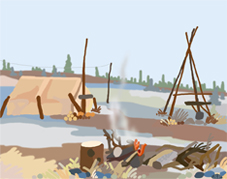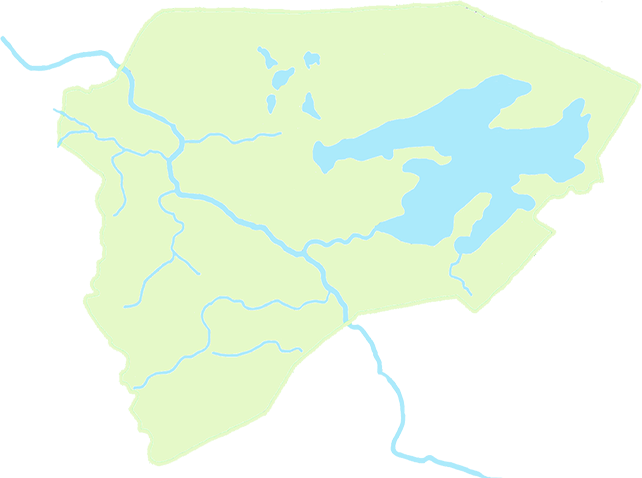Research in the Sahtú Region
Research Questions, Priorities and Coordination
Research on wildlife, habitat and communities in the Sahtú Region is guided by questions and priorities that are developed through ongoing dialogue of communities, co-management boards, government, industry, and academia. The Sahtú Environmental Research and Monitoring Forum [HYPERLINK] meets regularly to discuss research priorities and provide advice to researchers and research agencies. The Forum stresses importance of understanding the research context in the Sahtú Region, and building strong research relationships. Given the remoteness of the region, the high cost of conducting research, and the requirements for community engagement throughout the research cycle, researchers should benefit from the experiences of others – and initiatives should be well coordinated.
Licensing and Community Engagement
In accordance with the NWT Scientists Act, researchers need at least one of the following three research licenses to conduct research in the Northwest Territories: a Wildlife Research Permit, Archaeologists Permit and/or Scientific Research License. The Aurora Research Institute is responsible for administering the Scientists Act, so is a key contact for researchers seeking a license.
Researchers are advised to submit licensing applications at least three months prior to the planned start date of fieldwork. Communities in the Sahtú Region – and especially Ɂehdzo Got’ı̨nę – have a strong interest in research. Early community engagement can allow researchers to learn about the research context, including community knowledge, questions, and interest in participating in research activities. Wherever possible, license applications should demonstrate that community engagement has taken place and community inputs have been accommodated.
The Aurora Research Institute provides some recommendations for effective communication practices in the NWT . The Ɂehdzo Got’ı̨nę Gotsę́ Nákedı has considerable experience in research and community engagement and can provide suggestions and assistance. It may be helpful to discuss proposed research with the Sahtú Environmental Research and Monitoring Forum at one of their regular meetings.
Wildlife Research Permit
A valid Wildlife Research Permit is required to study wildlife or wildlife habitat in the Northwest Territories (NWT). It is an offence under the Wildlife Act to conduct a survey or census of wildlife or wildlife behaviour, administer drugs, collect or purchase specimens or carry out any scientific research relating to wildlife without a permit. Recommendations from the Ɂehdzo Got’ı̨nę Gotsę́ Nákedı and local Ɂehdzo Got’ı̨nę should be included with the application. Permits are issued by NWT Environment and Natural Resources.
Wildlife Research Permit Application Form
Wildlife Research Permit Recommendation Form
Archaeology License
Archaeological research is governed by the Archaeological Sites Act. Research is regulated by NWT Education, Culture and Employment’s Archaeology Program, and requires a Class 1 or Class 2 Permit. Information about the Archaeology Research Permit System is here.
Scientific Research License
Research that does not fall under Wildlife or Archaeology legislation requires a Scientific Research Licence. If research involves more than one discipline, both a permit and a Scientific Research License. Information on the research project is shared with other scientists and northern residents. Summaries of the research conducted each year are distributed to media, community organizations and other researchers. In addition, research information is added to existing and developing scientific databases. An ethical protocol must be submitted for review if the research involves people. University researchers can submit ethical protocols that have been approved through their institutions.
Before an Aurora Research Institute Scientific Research Licence is issued, the researcher must consult with, and gain support from the appropriate governing bodies. For research into social, cultural or economic aspects, or the testing of people contact the Métis Local and/or Band Council. Research involving land, water or wildlife requires engagement with the Ɂehdzo Got’ı̨nę Gotsę́ Nákedı and local Ɂehdzo Got’ı̨nę. Any research within the municipal limits is referred to Municipal Council(s).
Aurora Research Institute Community Comment Form.
Research Guidelines
Research guidelines can allow researchers to benefit from the experiences of many others in conducting research in the North over the years.
The NWT Cumulative Impact Monitoring Program and Aurora Research Institute have developed a guide for researchers in the NWT: “The recommendations contained in the document were collected from workshops and interviews held with dozens of monitoring and research experts - from government, regulatory agencies, communities, and academia - who work in the NWT. It is strongly recommended that researchers review this document.
“This document can be used at any stage in the research process, but is most effective if researchers use it to plan their projects from the outset. Implementation of these steps during the project design phase will lead to more effective use of time, resources and increased interest from the community.”
The Ɂehdzo Got’ı̨nę Gotsę́ Nákedı is in the process of developing a Monitoring Framework document and traditional knowledge research guidelines. Interim documents may be available upon request.
2012-2016 Caribou Populations Study
The main goal of the caribou research project is to develop a comprehensive understanding of the identities and relationships among caribou populations and Dene people in the Sahtú region in order to inform and prioritize management efforts. The project will bring together traditional knowledge and non-invasive population genetics to organize and understand the biological diversity of caribou and to develop an approach to caribou research that balances and accommodates aboriginal and scientific ways of knowing.

Caribou occupy a central place in the livelihoods and identities of Aboriginal people. Some caribou groups are more closely related to each other than others. Understanding the differences between caribou herds and populations is a question of interest to managers, ecologists, and First Nation hunters. For example, because caribou populations are often identified for management purposes it is important to understand if caribou from one area ever travel to different places and mate with other groups of caribou. In the Sahtú Region, caribou are given different names if they live in the mountains, or the boreal forests, or in the tundra. We are interested in understanding how groups of caribou are related to other groups of caribou in the Sahtú Region.
In the fall of 2012, the Sahtú Dene and Métis of the Northwest Territories passed a resolution detailing their resolve to conduct respectful caribou research and management. The caribou genetics study has developed collaborations with the Ɂehdzo Got’ı̨nę Gots’ę́ Nákedı and the Ɂehdzo Got’ı̨nę of Fort Good Hope, Norman Wells, Tulı́t’a, Délı̨nę, and Colville Lake to research and monitor caribou populations. It is critically important to develop a collaborative approach to wildlife management that uses multiple sources of data and knowledge systems to help define the boundaries of different groups of caribou. We hope to increase our understanding of caribou in the Sahtú Region with information from hunters and trappers as well as population genetics.
Population genetics allows scientists to understand how different groups of caribou are related to each other in much the same way humans are related to their extended families. A strong partnership with the communities of the Sahtú Region is essential to the project because the research is dependent on the voluntary collection of caribou fecal pellet (scat or poop) samples by local community members. We are able to take DNA from the outside mucus layer on caribou scat (poop) that is found frozen on the snow. Each caribou has its own individual DNA that is found in the mucus. Once the scat is brought to the lab, technicians take the mucus off a piece of scat from each individual caribou. By running the mucus through machines, we are able to identify each individual caribou and to see how that caribou is related to other caribou. This would be the same thing we could do with a piece of hair from a person to see if a sibling or parent was related to that person.
Preliminary results from the samples collected during the winter of 2013 can be found on the project website here: http://jeanpolfus.com/
Team Members
Funders
Sahtu Renewable Resources Board, Environment and Natural Resources - Northwest Territories, Cumulative Impact Monitoring Program - Northwest Territories, University of Manitoba, Environmental Studies Research Fund, Natural Sciences and Engineering Research Council of Canada (NSERC), Polar Continental Shelf Program of Natural Resources Canada
Publications
2014-2015 Budget
$184,850
HTOs/RRCs
coming soon







 Phone: 867-374-4040
Phone: 867-374-4040 Email:
Email: